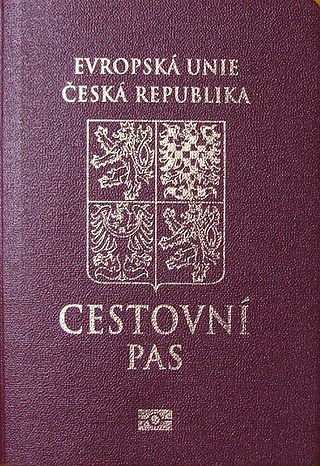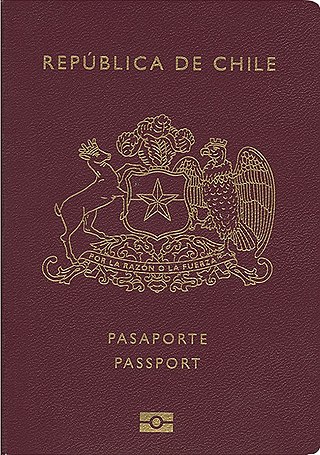
An identity document is a document proving a person's identity.

A permanent account number (PAN) is a ten-character alphanumeric identifier Foundational ID, issued in the form of a laminated "PAN card", by the Indian Income Tax Department, to any person who applies for it or to whom the department allots the number without an application. It can also be obtained in the form of a PDF file known as e-PAN from the website of the Indian Income Tax Department.

The citizenship law of the Czech Republic is based on the principles of jus sanguinis or "right by blood". In other words, descent from a Czech parent is the primary method of acquiring Czech citizenship. Birth on Czech territory without a Czech parent is in itself insufficient for the conferral of Czech citizenship. Every Czech citizen is also a citizen of the European Union. The law came into effect on 1 January 1993, the date of the dissolution of Czechoslovakia, and has been amended in 1993, 1995, 1996, 1999, 2002, 2003, and 2005. Since 1 January 2014, multiple citizenship under Czech law is allowed.

The Czech passport is an international travel document issued to nationals of the Czech Republic, and may also serve as proof of Czech citizenship. Besides enabling the bearer to travel internationally and serving as indication of Czech citizenship, the passport facilitates the process of securing assistance from Czech consular officials abroad or other European Union member states in case a Czech consular is absent, if needed.

A travel document is an identity document issued by a government or international entity pursuant to international agreements to enable individuals to clear border control measures. Travel documents usually assure other governments that the bearer may return to the issuing country, and are often issued in booklet form to allow other governments to place visas as well as entry and exit stamps into them.

Bilhete de Identidade, commonly abbreviated as BI, was the national identity card of Portugal. Established in 1919, the BI is gradually being replaced by the Cartão de Cidadão since 2008. BI's are valid for five years from date of issue for people under the age of 25, and then for ten years, and can be renewed 6 months before expiry. It is mandatory for all citizens above the age of 10, and available optionally for children.

The United States passport card is an optional national identity card and a travel document issued by the U.S. federal government in the size of a credit card. Like a U.S. passport book, the passport card is only issued to U.S. citizens and U.S. nationals exclusively by the U.S. Department of State. The passport card allows its holders to travel by domestic air flights within the U.S., and to travel by land and sea within North America. However, the passport card cannot be used for international air travel. US passport cards are used to verify identity and US citizenship. The requirements to attain the passport card are identical to the passport book and compliant to the standards for identity documents set by the REAL ID Act.

Argentine passport are issued to citizens of Argentina by the National Registry for People (ReNaPer). They were issued exclusively by the Argentine Federal Police up to 2011. Their primary use is to facilitate international travel.

The Mexican passport is the passport issued to Mexican citizens for the purpose of travelling abroad. The Mexican passport is also an official ID and proof of Mexican citizenship. According to the January 2024 Henley Visa Restrictions Index, holders of a Mexican passport can visit 159 countries without a visa, placing Mexico in the 22nd rank in terms of global travel freedom.

A Norwegian passport is the passport issued to nationals of Norway for the purpose of international travel. Beside serving as proof of Norwegian citizenship, they facilitate the process of securing assistance from Norwegian consular officials abroad.

A German passport is an identity document issued to nationals of Germany for the purpose of international travel. A German passport is, besides the German ID card and the German Emergency Travel Document, the only other officially recognised document that German authorities will routinely accept as proof of identity from German citizens. Besides serving as proof of identity and presumption of German nationality, they facilitate the process of securing assistance from German consular officials abroad. German passports are valid for ten years or six years and share the standardised layout and burgundy red design with other EU passports. Every German citizen is also a citizen of the European Union. The passport, along with the national identity card, allows for free rights of movement and residence in any of the states of the European Union, European Economic Area and Switzerland.

Swedish passports are issued to nationals of Sweden for the purpose of international travel. Besides serving as proof of Swedish citizenship, they facilitate the process of securing assistance from Swedish consular officials abroad.

Egyptian passports are issued to nationals of Egypt for the purpose of international travel. Besides serving as a proof of Egyptian citizenship, they facilitate the process of securing assistance from Egyptian consular officials abroad if needed. Egyptian passports are valid for seven years for adults, and is issued for lesser periods for school or college students, or those who have not finalized their status of the military conscription. Starting in 2008, The Egyptian government introduced newer machine-readable passport (MRP), in order to comply with international passport standards and requirements with 96.7% conformance to ICAO Document 9303. The newer passports offer better security and state-of-the-art anti forging parameters and have a soft cover.

Chilean passport is an identity document issued to citizens of Chile to facilitate international travel. Chilean passports are valid for worldwide travel and facilitate the access to consular services whilst abroad. They are issued by the Registro Civil e Identificación.

The Swedish national identity card is a non-compulsory biometric identity document issued in Sweden. It is one of two official identity documents issued by the Swedish Police, the other being the Swedish passport. It is only issued to Swedish citizens, and indicates the citizenship.

The Macau Resident Identity Card or BIR is an official identity card issued by the Identification Services Bureau of Macau. There are two types of Resident Identity Cards: one for permanent residents and one for non-permanent residents.

The Bulgarian identity card is a compulsory identity document issued in Bulgaria. The document is issued by the police on behalf of the Ministry of Interior and is the main form of identification on the territory of the Republic of Bulgaria. All Bulgarians are obliged by law to carry their identity cards with them at all times and are subject to fines should they not.
The Lebanese identity card is a compulsory Identity document issued to citizens of the Republic of Lebanon by the police on behalf of the Lebanese Ministry of Interior or in Lebanese embassies and consulates abroad free of charge. It is proof of identity, citizenship and residence of the Lebanese citizens.

The Ukrainian identity card or passport of the citizen of Ukraine is an identity document issued to citizens of Ukraine. Every Ukrainian citizen aged 14 or above that permanently resides in Ukraine must possess an identity card issued by the State Migration Service. Ukrainian identity cards can be used as a travel document to enter Ukraine, Georgia, Moldova, Russia and Turkey.
The British Certificate of Travel (COT) is an international travel document and a type of Home Office travel document issued by the UK Home Office to non-citizen residents of the United Kingdom who are unable to obtain a national passport or other conventional travel documents. Until 17 March 2008, the Certificate of Travel was called a Certificate of Identity (CID). It is usually valid for five years, or if the holder only has temporary permission to stay in the United Kingdom, the validity will be identical to the length of stay permitted.
























